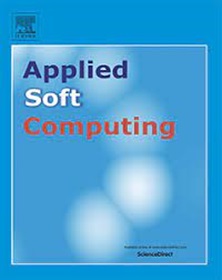异构空间共稀疏表示:利用模糊依赖和特征重构进行特征选择
IF 7.2
1区 计算机科学
Q1 COMPUTER SCIENCE, ARTIFICIAL INTELLIGENCE
引用次数: 0
摘要
特征选择是一种有效的降维方法。有大量的文献讨论了这个问题。它们大多优先考虑特征的分类能力,但往往没有充分考虑局部和全局子空间信息的协同效应,从而限制了特征选择在揭示数据内在结构方面的性能。本文提出了一种新的嵌入式特征选择模型——基于模糊依赖和特征重构的异构空间协同稀疏表示(HCoSRDC)。该模型通过构造模糊自信息算子将样本从特征空间非线性映射到模糊依赖空间,模糊依赖揭示了特征的分类能力,并捕获了数据中的局部子空间结构。此外,样本在其特征重构空间中稀疏自表示,以提取全局子空间结构,同时强调特征的独特性。结合局部稀疏表示和全局稀疏表示的一致性,学习特征的权重,进行特征选择。设计了一种求解HCoSRDC的算法。在各种基准数据集上进行了大量实验,实验结果表明,与最先进的特征选择模型相比,所提出的模型具有优越的性能。本文章由计算机程序翻译,如有差异,请以英文原文为准。
Heterogeneous space co-sparse representation: Leveraging fuzzy dependency and feature reconstruction for feature selection
Feature selection is an efficient approach to dimensionality reduction. There is a large number of literatures tackling this issue. Most of them prioritize classification ability of features, but often fail to fully consider the synergistic effect of local and global subspace information, thus limit the performance of feature selection in revealing the intrinsic structure of data. In this paper, a novel embedded feature selection model, called the heterogeneous space collaborative sparse representation for feature selection through leveraging fuzzy dependency and feature reconstruction (HCoSRDC), is proposed. In the proposed model, a fuzzy self-information operator is constructed to nonlinearly map samples from their feature space to a fuzzy dependency space, where the fuzzy dependency discloses classification ability of features and the local subspace structure in data is captured. Furthermore, samples are sparsely self-represented in their feature reconstruction space to extract global subspace structure while emphasizing feature distinctiveness. The consistency between local sparse representation and global sparse representation is integrated to learn weights of features for feature selection. An algorithm is designed to solve HCoSRDC. Extensive experiments on various benchmark datasets are conducted and experimental results demonstrate the superior performance of the proposed model in comparison with the state-of-the-art models for feature selection.
求助全文
通过发布文献求助,成功后即可免费获取论文全文。
去求助
来源期刊

Applied Soft Computing
工程技术-计算机:跨学科应用
CiteScore
15.80
自引率
6.90%
发文量
874
审稿时长
10.9 months
期刊介绍:
Applied Soft Computing is an international journal promoting an integrated view of soft computing to solve real life problems.The focus is to publish the highest quality research in application and convergence of the areas of Fuzzy Logic, Neural Networks, Evolutionary Computing, Rough Sets and other similar techniques to address real world complexities.
Applied Soft Computing is a rolling publication: articles are published as soon as the editor-in-chief has accepted them. Therefore, the web site will continuously be updated with new articles and the publication time will be short.
 求助内容:
求助内容: 应助结果提醒方式:
应助结果提醒方式:


